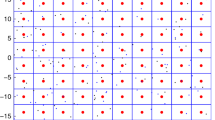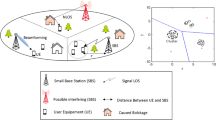Abstract
Different kinds of low transmit power, flexible cell extension and hyper dense base stations (BSs) overlaying on the well established macro cells, forming the hyper-dense multilayer heterogeneous wireless cell networks (HetNets), where the BSs in each tier are characterized by the differences in BSs transmit power, path loss exponent, tier-biasing factor and BSs spatial density, is the promising technology for 5th generation mobile networks and to support hot spots and cell edge coverage. The HetNets downlink rate modeling is one of the key and challenge problems for the random deployment characteristics of BSs in lower layer. In this paper, a three tier HetNets, which includes macro tier, Pico tier and Femto tier, is first modeled with the spatial point process in stochastic geometry theory; then, considering the BSs low transmit power, flexible cell extension and hyper BSs spatial density, a tractable downlink rate model based on the nearest distance and bias accepted factor is proposed, which adopt stochastic geometry theory and is easy to compute; last, the proposed downlink rate model is validated by numerical examples to confirm that the flexible cell extension BSs deployment in complex high traffic area with different path loss exponent is an effective scheme to improve quality of service.



Similar content being viewed by others
References
Rao, J. B., & Fapojuwo, A. O. (2014). A survey of energy efficient resource management techniques for multicell cellular networks. IEEE Communications Surveys & Tutorials, 16(1), 154–180.
Pappalardo, I., Quer, G., Rao, B. D., & Zorzi, M. (2016). Caching strategies in heterogeneous networks with D2D, small BS and macro BS communications. In IEEE international conference on communications (ICC) (pp. 1–6).
Serkan, A., Hazer, I., & Vincent, P. H. (2018). A tractable framework for the analysis of dense heterogeneous cellular networks. IEEE Transactions on Communications, 66(7), 3151–3171.
Abd El-atty, S. M., Gharsseldien, Z. M., & Lizos, K. A. (2018). Predictive reservation for handover optimization in two-tier heterogeneous cellular networks. Wireless Personal Communications, 98(2), 1637–1661.
Andrews, J. G., Baccelli, F., & Ganti, R. K. (2011). A tractable approach to coverage and rate in cellular networks. IEEE Transactions on Communications, 59(11), 3122–3134.
Oguejiofor, O., Abe, A., Aniedu, A. N., & Okechukwu, G. N. (2018). Distributed resource allocation for two-tier heterogeneous cellular networks. IUP Journal of Telecommunications, 10(2), 7–33.
Yang, H. H., Lee, J., & Quek, T. Q. S. (2016). Heterogeneous cellular network with energy harvesting-based D2D communication. IEEE Transactions on Wireless Communications, 15(2), 406–419.
Jo, H.-S., Sang, Y. J., Xia, P., & Andrews, J. G. (2011). Heterogeneous cellular networks with flexible cell association: A comprehensive downlink SINR analysis. IEEE Transactions on Wireless Communications, 11(10), 3484–3495.
Park, J.-B., & Kim, K. S. (2018). Load-balancing scheme with small-cell cooperation for clustered heterogeneous cellular networks. IEEE Transactions on Vehicular Technology, 67(1), 633–649.
Xu, M., Tao, X., & Yang, F. (2016). On revenue efficiency for coordinated multipoint transmission in hetero-generous cellular networks. In IEEE wireless communications and networking conference (pp. 1–5).
Andersson, G., Västberg, A., Devlic, A., & Cavdar, C. (2016). Energy efficient heterogeneous network deployment with cell DTX. In IEEE international conference on communications (ICC) (pp. 1–6).
Ikuno, J., Wrulich, M., & Rupp, M. (2010). System level simulation of LTE networks. In IEEE vehicular technology conference (pp. 1–5).
Brown, T. (2000). Cellular performance bounds via shotgun cellular systems. IEEE Journal on Selected Areas in Communications, 18(1), 2443–2455.
Baccelli, F., & Blaszczyszyn, B. (2009). Stochastic geometry and wireless networks, Volume 1: (Theory). Foundations and Trends in Networking, 3(3–4), 249–449.
Acknowledgements
This work is supported in part by Natural Science Fund for colleges and universities in Jiangsu Province, China (No. 17KJD510006, No.19KJD140004), and research initiation fund in Wuxi vocational institute of commerce, China (No. RS2015B006). We express our thanks to the Editors and anonymous reviewers for their detailed comments and valuable contribution to improve our manuscript.
Author information
Authors and Affiliations
Corresponding author
Additional information
Publisher's Note
Springer Nature remains neutral with regard to jurisdictional claims in published maps and institutional affiliations.
Appendix
Appendix
1.1 Proof of Theorem
In this appendix, we will provide the proof of theorem in part three and establish the average communication rate model of \(j_{ 0} {\text{th}}\) tier in HetNets based on the nearest distance, according to the Shannon formula in information theory. Denoting the communication rate in \(j_{ 0} {\text{th}}\) tier as \(\tau_{j}\), which is the mean over distance \(r\) and distributed channel power.
where \(SINR\) is the ratio of signal to interference noise, which could be obtained from (4) in Lemma 1, \(f_{r} \left( r \right)\) is the distribution function of the nearest between user and BS, which comes from (5) in Lemma 2, \(B_{{j_{0} }}\) denotes the base station which the user associates with in \(j_{ 0} {\text{th}}\) tier. According to \({\mathbb{E}}\left( X \right) = \int_{0}^{\infty } {{\mathbb{P}}\left[ {X > x} \right]dx}\) for \(X > 0\), we could obtain,
In (8), \(Q = \sum\limits_{\kappa = 1}^{K} {\sum\limits_{{i \in \phi_{\kappa } /B_{{j_{0} }} }} {P_{\kappa } h_{\kappa i} \left| {Y_{\kappa i} } \right|^{{ - \alpha_{\kappa } }} } + W/L_{0} }\) is the sum of interference and noise. For \({\mathbb{P}}\left( {g_{{j_{0} }} \succ P_{{j_{0} }}^{ - 1} r^{{\alpha_{{j_{0} }} }} Q\left( {e^{t} - 1} \right)} \right)\), we could deduced it as follows,
In (9), \(I_{\kappa } = \sum\limits_{{i \in \phi_{\kappa } /B_{j0} }} {P_{\kappa } h_{\kappa i} \left| {Y_{\kappa i} } \right|^{{ - \alpha_{\kappa } }} }\) denotes the interference from BSs in kth tier; \(SNR = \frac{{P_{{j_{0} }} L_{0} r^{{\alpha_{{j_{0} }} }} }}{W}\) in (10) is the signal to noise ration of user in jth tier. \({\mathbb{E}}_{{I_{\kappa } }} \left[ {\exp \left( { - P_{{j_{0} }}^{ - 1} r^{{\alpha_{{j_{0} }} }} \left( {e^{t} - 1} \right)I_{\kappa } } \right)} \right]\) in (11) could be deduced as follows, \(\begin{aligned} & {\mathbb{E}}_{{I_{\kappa } }} \left[ {\exp \left( { - P_{{j_{0} }}^{ - 1} r^{{\alpha_{{j_{0} }} }} \left( {e^{t} - 1} \right)I_{\kappa } } \right)} \right] \\ \text{ } & \quad \text{ } = {\mathbb{E}}_{{\phi_{\kappa } }} \left[ {\exp \left( { - P_{{j_{0} }}^{ - 1} r^{{\alpha_{{j_{0} }} }} \left( {e^{t} - 1} \right)\sum\limits_{{i \in \phi_{\kappa } /B_{{j_{0} }} }}^{{}} {P_{\kappa } h_{\kappa i} \left| {Y_{\kappa i} } \right|^{{ - \alpha_{\kappa } }} } } \right)} \right] \\ \text{ } & \quad \text{ } = {\mathbb{E}}_{{\phi_{\kappa } }} \left[ {\exp \left( { - P_{{j_{0} }}^{ - 1} P_{\kappa } r^{{\alpha_{{j_{0} }} }} \left( {e^{t} - 1} \right)\sum\limits_{{i \in \phi_{\kappa } /B_{j0} }}^{{}} {h_{\kappa i} \left| {Y_{\kappa i} } \right|^{{ - \alpha_{\kappa } }} } } \right)} \right] \\ \text{ } & \quad \text{ } = {\mathbb{E}}_{{\phi_{\kappa } }} \left[ {\prod\limits_{{i \in \phi_{\kappa } /B_{{j_{0} }} }} {\exp \left( { - P_{{j_{0} }}^{ - 1} P_{\kappa } r^{{\alpha_{{j_{0} }} }} \left( {e^{t} - 1} \right)h_{\kappa i} \left| {Y_{\kappa i} } \right|^{{ - \alpha_{\kappa } }} } \right)} } \right] \\ \end{aligned}\)
In (12) \({\mathbb{E}}\left\{ {\prod\limits_{x \in \phi } {f\left( x \right)} } \right\} = \exp \left\{ {1 - \lambda \int_{{R^{2} }} {\left( {1 - f\left( x \right)} \right)dx} } \right\}\) follows from the probability generating functional of the PPP, which states for some function \(f\left( x \right)\) that \({\mathbb{E}}\left\{ {\prod\limits_{x \in \phi } {f\left( x \right)} } \right\} = \exp \left\{ {1 - \lambda \int_{{R^{2} }} {\left( {1 - f\left( x \right)} \right)dx} } \right\}\) [5]; \(Z_{\kappa } = \left( {\hat{P}_{\kappa } \hat{\delta }_{\kappa } } \right)^{{1/\alpha_{\kappa } }} r^{{\hat{\alpha }_{\kappa } }}\) in (13) denotes the at least distance of the closet interference between tagged user and inference BSs in \(\kappa\) tier [8], and in (14), \(\mathcal{Z}\left[ {\left( {e^{t} - 1} \right),\alpha_{\kappa } ,\hat{\delta }_{\kappa } } \right] = \left( {e^{t} - 1} \right)^{{1/\alpha_{\kappa } }} \int_{{\left[ {\hat{\delta }_{\kappa } /\left( {e^{t} - 1} \right)} \right]^{{2/\alpha_{\kappa } }} }}^{\infty } {\frac{1}{{1 + \mu^{{\alpha_{\kappa } /2}} }}} d\mu\). Plugging (14) in (11), then \({\mathbb{P}}\left( {g_{{j_{0} }} \succ P_{{j_{0} }}^{ - 1} r^{{\alpha_{{j_{0} }} }} Q\left( {e^{t} - 1} \right)} \right)\) is,
substituting the (15) formula into the (9) form, then the communication rate \(\tau_{{j_{0} }}\) in jth tier is,
and,
where \({}_{2}F_{1} \left[ {1,\text{ }1 - \frac{2}{{\alpha_{\kappa } }};\text{ }1 - \frac{2}{{\alpha_{\kappa } }};\text{ }\frac{{1 - e^{t} }}{{\hat{\delta }_{\kappa } }}} \right]\) is a hyper geometry function.
And the proof is completed.
Rights and permissions
About this article
Cite this article
Fang, S. Nearest Distance Based Downlink Rate Modeling in Hyper-dense Heterogeneous Wireless Cell Networks. Wireless Pers Commun 114, 2769–2781 (2020). https://doi.org/10.1007/s11277-020-07502-z
Published:
Issue Date:
DOI: https://doi.org/10.1007/s11277-020-07502-z




